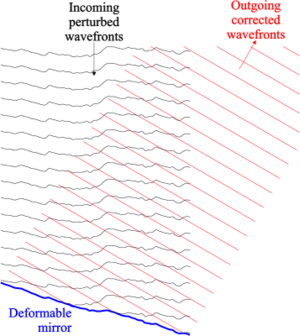Adaptive optics facts for kids
Adaptive optics is a clever technology. It makes optical systems work better. It does this by fixing blurry effects. These blurs come from rapidly changing light distortions. It is often used with telescopes. It helps remove the blur from Earth's atmosphere. This blur is also known as "astronomical seeing."
Adaptive optics measures how light is distorted. Then it quickly corrects it. It uses special mirrors that can change shape. Or it uses materials that can change how they bend light. Scientists understood this idea for a long time. But it became practical only in the 1990s. This was thanks to big advances in computer technology.
Contents
What is Adaptive Optics?
Adaptive optics helps improve images. It works by correcting light distortions. These distortions can make images blurry. Think of looking at a star through a telescope. The air in our atmosphere makes the star twinkle. This twinkling makes the star look blurry. Adaptive optics helps make it clear.
How Does Adaptive Optics Work?
This technology finds the light distortion. It then fixes it very quickly. It uses special mirrors called "deformable mirrors." These mirrors can change their shape many times per second. This change corrects the distorted light. It makes the image sharp again.
Adaptive vs. Active Optics
Adaptive optics is different from active optics. Active optics also corrects mirrors. But it works much slower. It fixes the main mirror's shape over a longer time. Adaptive optics works super fast. It corrects quick changes in light.
Tip-Tilt Correction
The simplest type of adaptive optics is "tip-tilt" correction. Imagine a light wave coming from a star. Sometimes the whole wave tilts a little. This makes the star image move slightly. Tip-tilt correction fixes these small tilts. It uses a fast-moving mirror. This mirror rotates slightly on two axes.
Why is Tip-Tilt Important?
A lot of the blur from the atmosphere is just tilting. So, fixing these tilts helps a lot. Tip-tilt mirrors are used in many telescopes. They are used for looking at stars at night. They also help when looking at the Sun. They make images much clearer. This is better than what the atmosphere usually allows.
Tip-tilt mirrors are like a simple version of deformable mirrors. They have only one part that can tilt. More complex adaptive optics mirrors have many small parts. Each part can tilt on its own.
Images for kids
-
Astronomers at the Very Large Telescope site in Chile use adaptive optics.
-
A laser beam directed toward the centre of the Milky Way. This laser beam can then be used as a guide star for the AO.
See also
 In Spanish: Óptica adaptativa para niños
In Spanish: Óptica adaptativa para niños








